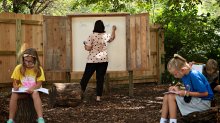With Safety in Mind, Schools Take Classes Outdoors
There are plenty of logistics to consider, but educators say outdoor classes keep kids and teachers safer—and provide much-needed fresh air.
Your content has been saved!
Go to My Saved Content.Sara Allis’ fourth-grade classroom looks pretty nontraditional this year: For several periods each day, her students are now scattered throughout a clearing in the Maine woods, sitting atop five-gallon buckets spread six feet apart.
This is how some schools are mitigating the risks of Covid-19 transmission as they reopen for the new year, creating outdoor spaces that classes can use as needed by erecting tents, setting up benches and whiteboards, and marking asphalt with tape or paint at six-foot intervals.
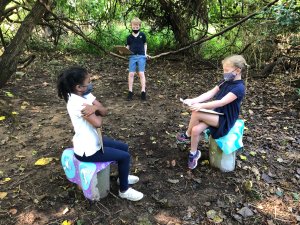
Learning in the great outdoors isn’t a new phenomenon, but with the CDC suggesting that school leaders look for opportunities to take learning outdoors more frequently—and with some states like Indiana issuing strong guidance in support of the approach—schools across the country are experimenting with fresh-air instruction in ways they’ve never tried before.
New York City’s Department of Education launched an Outdoor Initiative, for example, encouraging schools to consider using public parks or closed-off streets as exterior classrooms—and many schools are planning ways to implement that when they reopen for in-person instruction. Even Dr. Anthony Fauci, who heads the National Institute of Allergy and Infectious Diseases, has weighed in on the matter: “Get as much outdoors as you can,” he said in a recent conversation with Rhode Island Gov. Gina Raimondo about reopening schools. “If you look at the superspreader events that have occurred, they’re almost always inside.”
It’s the kind of guidance, of course, that can drive teachers to distraction. In conversations we’ve seen on social media, some educators are highlighting shortcomings such as a lack of funding for outdoor gear like tents, seating, and rain wear, for example, or the challenge of weather conditions.
“Not every school has a lot of outdoor space,” says AM Pines via Twitter. “I taught at Pittsburgh Public [Schools] for a bit and most of our outdoor space was a parking lot with parked cars. What do you do about the weather? It rains in a lot of the country. What do you do if there are wildfires and bad air quality?”
Prior to the pandemic, though, Allis and her fellow teachers had already hatched plans to build more sustainable outdoor spaces, breaking ground and erecting the basic structure for an outdoor pavilion. Now, even though the project isn’t entirely finished, teachers are using the pavilion for outdoor lessons. They’re not alone: Schools across the country are building structures in schoolyards and parking lots to accommodate outdoor learning—from simple tarps to elaborate platforms with roofs.
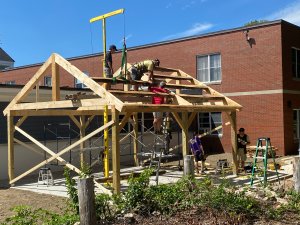
Meanwhile, in Winnipeg, Canada—where the average high winter temperature hovers around 26 degrees—gym teacher Jesse Klym is repeating the mantra, “There is no such thing as bad weather, just bad clothing.”
Educators at Marshwood Great Works School in South Berwick, Maine, tend to agree and plan to take classes outdoors frequently, even in some conditions that may look intemperate to others. “We’re lucky that we’re already teaching kids sports and activities because this is where we live, and we want them outside no matter what. We go outside year round,” says Allis, the fourth-grade teacher. “Our kids sled every day in a normal year. They come prepared and dressed for recess.”
Before heading outside, Allis’ students fill their five-gallon buckets—donated by a local business—with supplies: slates, dry-erase markers, water bottles, and clipboards. Allis has made a few simple adjustments to her instruction—such as using a small voice amplifier to project in the outdoor spaces. So far, it’s working: “They’re happy, and I’m happy out there,” she says. And kids are continuing to learn: On the day we spoke, her students studied place values, read stories, and wrote in gratitude journals.
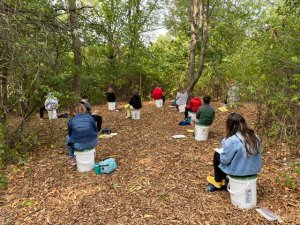
At North Rowan Elementary School in Salisbury, North Carolina, three basic outdoor classrooms provide space for kids to take a break from wearing masks in a safe, socially distanced way. “I always believe less is best. It’s nothing fancy. It’s a platform,” says principal Katherine Bryant-Thrower. “And then I also believe in utilizing what we have in our earth. So: a cut-down tree is used as the ledge for the benches, and then the wooden seat part is just nailed to it.”
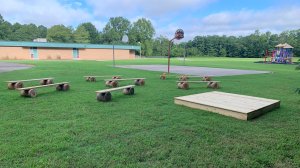
Bryant-Thrower is urging her teachers to think about outdoor instruction as a way to expand student perspectives and explore new pedagogical methods. Teachers determine if and when to use the outside space, self-schedule their rotations in the outdoor classrooms, and make adjustments depending on weather, learning goals, and student interest.
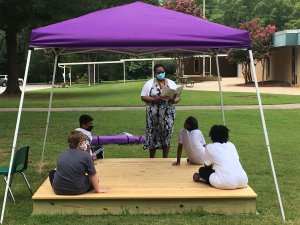
Using the environment as a teacher—one of the key principles of the Reggio Emilia approach—is vital to learning at Children First, a small preschool in Durham, North Carolina. Founder and director Donna King acknowledges that taking learning outside creates logistical issues, but the challenges can produce new ways to think about how students learn. “A huge value for us is a healthy relationship with risk, so we have a lot of building stuff that lets kids build high or erect their own obstacle course,” says King.
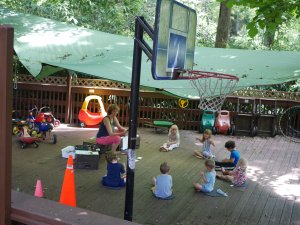
Taking students outdoors doesn’t have to be an all-or-nothing strategy. At Bryant-Thrower’s school, teachers determine if and when to use the outside space; self-schedule their rotations in the outdoor classrooms; and make adjustments depending on weather, learning goals, and student interest.
“Think about it as a work in progress always,” King says. She says that having “systems for everything” can help teachers keep transitions running smoothly, but in the end, “you try something. You watch what happens, and then you adjust. Then there is incredible joy in problem-solving.”
